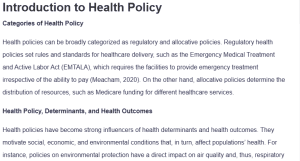Introduction to Health Policy
Categories of Health Policy
Health policies can be broadly categorized as regulatory and allocative policies. Regulatory health policies set rules and standards for healthcare delivery, such as the Emergency Medical Treatment and Active Labor Act (EMTALA), which requires the facilities to provide emergency treatment irrespective of the ability to pay (Meacham, 2020). On the other hand, allocative policies determine the distribution of resources, such as Medicare funding for different healthcare services.
Health Policy, Determinants, and Health Outcomes
Health policies have become strong influencers of health determinants and health outcomes. They motivate social, economic, and environmental conditions that, in turn, affect populations’ health. For instance, policies on environmental protection have a direct impact on air quality and, thus, respiratory health outcomes (Green et al., 2021; World Health Organization, 2021)
Public Policy vs. Health Policy
While public policy includes all governmental actions that impact society, health policy is defined as decisions, plans, and actions carried out to accomplish explicit healthcare objectives. Health policy is merely a part of public policy that directly or indirectly impacts health systems and population health outcomes (American Public Health Association, 2024).
Civil Rights Act and Health Care
The Civil Rights Act of 1964 is both a civil rights and health policy, given that its impact on the delivery and accessibility of healthcare has wholly changed. As such, it ended this long history of healthcare disparities by making any discrimination in healthcare facilities receiving federal funding unlawful. Title VI of this Act required that all hospitals receiving funding from Medicare provide services without discrimination, desegregating many health facilities. This became particularly a great wave in the South, where segregation in hospitals was a long-standing practice (U.S. Department of Labor, 2024).
The Act resulted in massive improvements in access to health care services for the disadvantaged population, increased utilization of medical facilities, equal medical treatment, and health outcomes for minority populations. Increased integration of healthcare facilities after the passing of this Act translated into greater diversity of medical personnel and increased cultural competence in delivering health services (National Academies of Sciences, Engineering, and Medicine et al., 2023). This dual role of both civil rights and health policy shows that social legislation can directly influence populations’ health and healthcare systems’ structure.
References
American Public Health Association. (2024). Advocacy for public health. https://www.apha.org/policies-and-advocacy/advocacy-for-public-health
Green, H., Fernandez, R., & MacPhail, C. (2021). The social determinants of health and health outcomes among adults during the COVID‐19 pandemic: A systematic review. Public Health Nursing, 38(6). https://doi.org/10.1111/phn.12959
Meacham, M. R. (2020). Longest’s health policymaking in the United States (7th ed.). Jones & Bartlett Learning.
National Academies of Sciences, Engineering, and Medicine, Health and Medicine Division, Board on Population Health and Public Health Practice, Committee on the Review of Federal Policies that Contribute to Racial and Ethnic Health Inequities, Geller, A. B., Polsky, D. E., & Burke, S. P. (Eds.). (2023). Federal policy to advance racial, ethnic, and tribal health equity. National Academies Press. https://www.ncbi.nlm.nih.gov/books/NBK596397/#:~:text=Title%20VI4%20of%20the,et%20al.%2C%202022).
U.S. Department of Labor. (2024). Legal Highlight: The Civil Rights Act of 1964. Dol.gov; U.S. Department of Labor. https://www.dol.gov/agencies/oasam/civil-rights-center/statutes/civil-rights-act-of-1964
World Health Organization. (2021). Social determinants of health. World Health Organization. https://www.who.int/health-topics/social-determinants-of-health
ORDER A PLAGIARISM-FREE PAPER HERE
We’ll write everything from scratch
Question
Module One Discussion: Introduction to Health Policy
- Compare and contrast two basic categories of health policies and give an example of each.
- Describe the connections among health policies, health determinants, and health.
- Distinguish between public policy and health policy.
- Referring to United States (US) Hospitals and the Civil Rights Act of 1964, why is the Civil Rights Act a health policy as well as a civil rights policy?
Introduction to Health Policy


